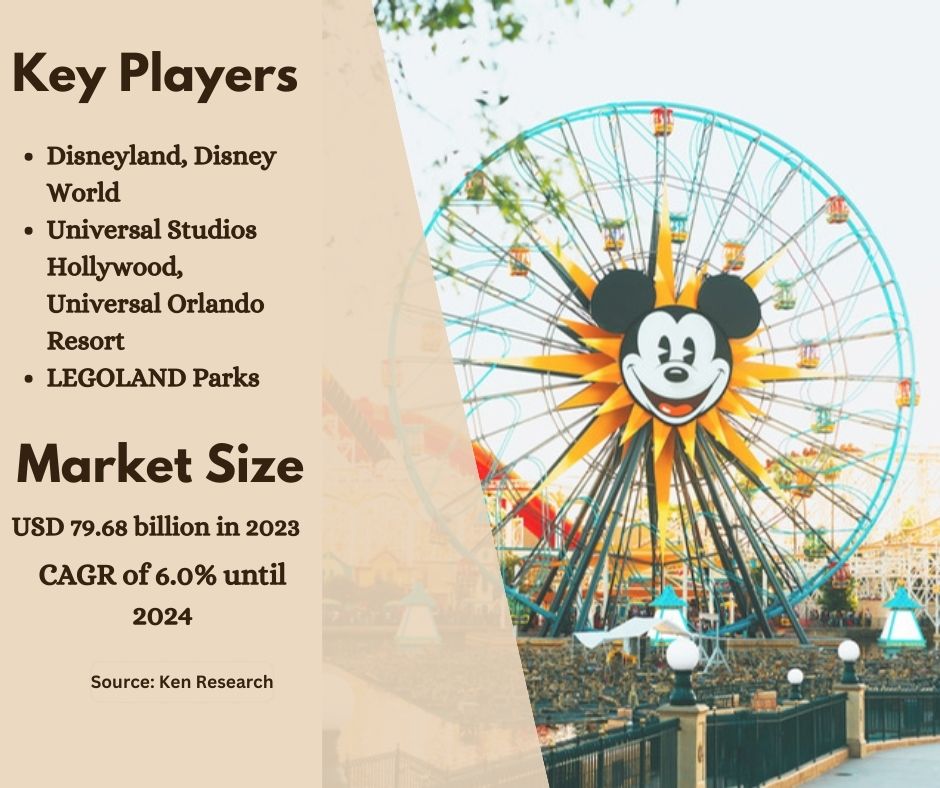The theme park industry isn’t just about roller coasters and cotton candy anymore. It’s a multi-billion dollar global phenomenon, offering immersive experiences that cater to all ages and thrill levels. Let’s take a wild ride through the theme park market, exploring its size, trends, key players, and what the future holds for this exciting industry.

A Global Playground Worth Billions
- Market Size: The global theme park market is estimated at a staggering USD 79.68 billion in 2023 (Ken Research), and is expected to grow at a healthy CAGR (Compound Annual Growth Rate) of 6.0% until 2024. That’s a lot of laughter, screams (of joy, hopefully!), and popcorn!
- Market Share: Theme parks hold a significant share of the broader amusement park market, which is estimated to be even larger at USD 51646.0 million in 2022 (Ken Research). Theme parks offer a more immersive and themed experience compared to traditional amusement parks, justifying their larger slice of the pie.

Key players in Theme Park Market
The industry boasts a diverse cast of characters, each with their own unique strengths:
- Global Giants: These companies have a presence all over the world, creating iconic theme park experiences. Think Walt Disney Parks and Resorts (Disneyland, Disney World), Universal Parks & Resorts (Universal Studios Hollywood, Universal Orlando Resort), and Merlin Entertainments (LEGOLAND Parks, Madame Tussauds).
- Regional Champions: These companies dominate specific regions, offering exciting theme park experiences tailored to local preferences. Examples include OCT Parks China (Happy Valley amusement parks), Everland (South Korea), and Six Flags Entertainment Corporation (primarily operates in North America).
The Future is Now: Trends Shaping the Theme Park Industry
The theme park market analysis is constantly evolving, adapting to changing demographics and preferences. Here are some key trends to watch:
- The Rise of Themed Entertainment: Theme parks are incorporating popular movie franchises, video games, and even TV shows into their attractions, blurring the lines between reality and fantasy. Think Harry Potter rides at Universal Studios or Star Wars: Galaxy’s Edge at Disneyland.
- Tech Takes Center Stage: Virtual reality (VR) and augmented reality (AR) technologies are being used to create immersive experiences that transport guests to new worlds. Imagine riding a roller coaster that takes you through a virtual reality jungle!
- Focus on Family Fun: Theme parks are increasingly catering to families, with dedicated rides, shows, and amenities for all ages. This ensures a fun-filled experience for everyone, from toddlers to grandparents.
- Theming Goes Global: Theme park operators are recognizing the growing appeal of international markets, building parks that cater to local cultures and preferences. This trend fosters cultural exchange and attracts a wider audience.
Demystifying Demographics: Who Visits Theme Parks?
The theme park market caters to a broad demographic, but some key groups stand out:
- Millennials & Gen Z: These tech-savvy generations are driving the demand for immersive experiences and cutting-edge technology in theme parks.
- Families: Theme parks offer a fun and convenient way for families to spend quality time together, creating lasting memories.
- Experience Seekers: People of all ages are looking for unique and thrilling experiences, and theme parks offer an escape from the ordinary.
Theme Parks vs. Amusement Parks: What’s the Difference?
While both offer entertainment, there are some key distinctions:
- Theme: Theme parks have a central theme that ties everything together, from rides and shows to the overall atmosphere. Amusement parks offer a more diverse collection of rides and attractions, with less focus on a unifying theme.
- Immersion: Theme parks create a more immersive experience, transporting guests to a different world. Amusement parks typically offer a more traditional collection of rides and attractions.
- Target Audience: Theme parks often cater to a specific age group or demographic, while amusement parks aim to appeal to a broader audience.
The Connection to Gaming and Gambling Markets:
The theme park industry shares some similarities with the gaming and gambling market:
- Focus on Entertainment: All three industries aim to provide fun and engaging experiences for their target audience.
- Immersive Experiences: The rise of VR and AR technologies is impacting all three industries, creating more immersive experiences for customers.
- Family Entertainment: All three industries can be enjoyed by families, offering entertainment options for all ages.
The Future is Bright: Soaring High with the Theme Park Industry
The theme park industry shows no signs of slowing down. By embracing new technologies, catering to diverse demographics, and creating immersive experiences, theme parks will continue to be a thriving source of entertainment for people of all ages. Whether you’re a thrill-seeker, a movie buff, or simply looking for a fun-filled family outing, theme parks offer something for everyone. So, grab your tickets, fasten your seatbelts, and get ready for a wild ride!

